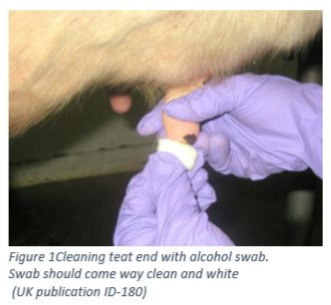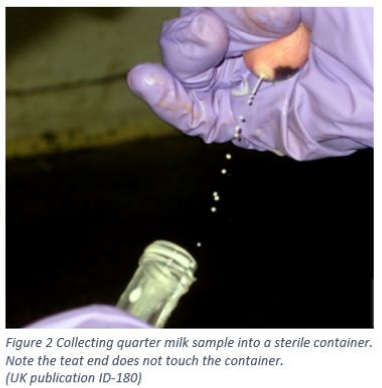Using SCC to Evaluate Subclinical Mastitis Cows
Using SCC to Evaluate Subclinical Mastitis Cows
Mastitis is the most important and costliest infectious disease on a dairy farm. A National Mastitis Council report calculated that subclinical mastitis costs the United States dairy industry more than $1 billion every year. Mastitis affects both the quality and quantity of the milk produced by a cow. Identifying cows with high somatic cell counts (SCC) can aid in the implementation of additional management practices to reduce bulk tank SCC. Identifying cows with clinical mastitis is easily done in the milking parlor, however, identifying subclinical high SCC cows is more difficult since these cows do not show any outward signs of infection. Herds that are enrolled in Dairy Herd Improvement (DHI) testing are able to easily identify high SCC cows via monthly testing. Cows above 200,000 somatic cells/ ml are considered to be subclinically infected and should be considered high SCC cows.
First- Identify High SCC Cows
High SCC cows can be identified via DHI monthly milk testing or using the California Mastitis Test (CMT) in the parlor. The Test Day Bulk Tank report (DHI 421) or DHI-lab Hot Sheet lists cows by their contribution of SCC to the bulk tank, quickly enabling a producer to target high SCC cows. When using a CMT paddle to check for infected quarters, use a clean CMT paddle, sample milk from each quarter and use an equal amount of reagent. Thoroughly mix the contents. Any quarter that shows distinct thickening or very mild gelling (a CMT score of trace) should be considered subclinically infected (Table 1). After identifying high SCC cows, several steps should be taken regarding their future.
| CMT Score | SCC Range | Gelling | Interpretation |
| Negative | 0-200,000 | None | Healthy quarter |
| Trace | 200,000-400,000 | Very mild | Subclinical Mastitis |
| 1 | 400,000-1,200,000 | Mild | Subclinical Mastitis |
| 2 | 1,200,000-5,000,000 | Moderate | Serious Mastitis Infection |
| 3 | Over 5,000,000 | Heavy, almost solidifies | Serious Mastitis Infection |
Table 1 Interpretation of CMT Scores (Adapted from Jasper, D.E. 1967. Proc Of National Mastitis Council)
Step 1. Identify mastitis pathogen via culturing milk samples
Ideally, when high SCC cows have been identified, the next step should include culturing each infected quarter of the cow. Producers may send individual quarter milk samples to their veterinarian, veterinary diagnostic lab (samples may need to be submitted by your veterinarian), or milk processor, if they provide culturing services. Another option is on-farm culturing which provides mastitis pathogen results within 24 hours. Information on what is required to begin on-farm culturing can be found here. (For those without internet access, copies of articles can be obtained from your local UK Extension Office.)
Key points when collecting milk samples to be cultured
- When culturing the cow, use a CMT paddle to determine the infected quarter(s). Any quarter that shows any gelling or a CMT score of Trace should be cultured (Table 1). More information on how to properly use a CMT paddle can be found here.
- After determining the infected quarter(s) obtain an aseptic (as clean as possible) quarter milk sample. Step by step instructions for aseptic sampling may be found here. Essentially,
- Begin with a clean dry teat
- Wear clean fresh/new gloves
- Use alcohol swabs to clean the end of the teat, making sure the swab is white/ clean when done (Figure 1)
- Use a sterile container to collect the quarter milk samples
- Do not touch the collar of the container to the end of the teat! (Figure 2)
- Do not contaminate the inside of the cap during collection


Step 2. Pathogen identification
Once the pathogen has been determined via culturing, producers should consult with their veterinarian regarding appropriate management changes to prevent infections in additional cows and determine if lactating cow therapy might be appropriate for this cow. In general, only clinical cases of mastitis should be treated during lactation. A list of common mastitis pathogens can be found in Table 2 and a summation of where they come from as well as how they are transmitted.
Table 2 Common mastitis pathogens, their reservoirs and transmission adapted from the “Laboratory handbook on bovine mastitis” from the National Mastitis Council
| Pathogen | Type | Reservoir | Transmission |
| Streptococcus agalactiae (Strep. ag) | Contagious | Udder tissues | Cow to cow during milking |
| Staphylococcus aureus (Staph. aureus) |
Contagious |
Infected udder tissues- does not readily colonize healthy skin |
Cow to cow during milking process |
| Mycoplasma species |
Contagious |
Infected udders, respiratory tracts and urogenital tracts | Cow to cow during milking process, contaminated intramammary treatments, contaminated hands, airborne transmission (poor ventilation) |
|
Streptococci (environmental Streps) not Strep ag. Streptococcus parauberis (formerly Strep. uberis) Streptococci equinus (formerly Strep. bovis) |
Environmental |
Soil, skin, infected udders, and environment |
Between milkings when teats contact the envoronment |
| Coagulase Negative Staphylococcus (CNS) species | Normal skin flora | Opportunistic infect via skin | |
| Staph. chromogenes | Contagious | Normal skin flora | Readily colonize teat canal |
| Staph. hyicus | Contagious | Normal skin flora | Readily colonize teat canal |
| Staph. simulans | Contagious | Normal skin flora | Opportunistic infect via skin |
| Staph. epidermidis | Contagious | Normal skin flora | Opportunistic infect via skin |
| Coliform bacteria | |||
| Escherichia coli (E. coli) | Environmental | bedding, manure and soil | |
| Klebsiella pneumoniae | Environmental | organic bedding |
Between milkings when teats contact environment |
| Klebsiella oxytoca | Environmental | organic bedding | |
| Enterobacter aerogenes | Environmental | bedding, manure and soil |
Contagious mastitis pathogens
Transmission of contagious mastitis pathogens occurs in the milking parlor via milking machine, milkers’ hands, teat cups and towels. Proper udder hygiene and post-milking teat dipping are key to preventing the transmission of contagious mastitis pathogens. The best way to control contagious mastitis is to prepare teats properly prior to milking, use properly sized and functioning milking equipment, and disinfect teats after every milking using a research-determined effective germicide preparation or teat dip. More information on proper milking procedures can be found here.
Goals: 0% of cows infected with Streptococcus agalactiae and Mycoplasma.
Less than 5% of cows infected with Staphylococcus aureus.
Environmental mastitis pathogens
The environment of the dairy cow is key to the transmission of environmental mastitis pathogens. Sources of transmission are manure, bedding, feed, dirt, mud, and water. The best way to control environmental mastitis is to use a tested and effective germicidal pre and post dip, use properly sized and functioning milking equipment, and maintain an environment that is as clean and dry as possible. Not only should the milking cow environment be clean and dry; the dry cow pen, springing heifer pen and maternity pens should also be clean and dry.
Goal: Clinical cases of environmental mastitis should be no more than 2% of total
cows in the herd each month.
Step 3. Determine which of the options below works best for each high SCC cow
A) Exclude milk from bulk tank
Early and mid-lactation cows with high SCC should be excluded from the bulk tank in order to maintain premiums from the milk processor, if necessary. A quarter milker could also be used to exclude milk from high SCC quarters. Use the bulk tank percent contribution from the DHI-lab, Hot-sheet or the DHI-421 Test Day Bulk Tank report to determine which cows are contributing the largest amount of SCC to the bulk tank.
B) Change the milking order
Producers should treat high SCC cows the same way they treat clinical mastitis cows. Milking high SCC and clinical mastitis cows last decreases the spread of contagious mastitis pathogens to uninfected cows during the milking process. If this is not practical, then identify the high SCC and clinical mastitis cows with a leg band and milk them with a different milking unit than the rest of the milking herd. Flushing a milker out with water or disinfecting solution after a high SCC cow does not prevent the spread of the pathogen. Reducing the spread of contagious mastitis pathogens will prevent an increase of SCC in the bulk tank due to a reduction in number of new infections in the herd.
C) Early dry off
High SCC cows that are in late lactation and late gestation are candidates for early dry off. Late lactation/ late gestation cows are already naturally decreasing in milk production and if the cow has high SCC or mastitis an even further decrease in milk production is seen. Instead of treating the cow with lactating cow therapy, dry them off early and treat with a pathogen-specific dry cow therapy as directed by your veterinarian followed by an effective teat sealant.
As long as dry cow nutrition, body condition score, and heat stress are continuously monitored, a longer dry period should have minimum negative impacts on the next lactation.
D) Cull the cow
Chronically infected cows can be found by comparing their current test SCC results with their previous test SCC results. Any cow over 200,000 cells for multiple DHI tests is a chronically infected cow. Digging further into the cow’s records can help justify culling. If the cow has had a high SCC each month, it is better to cull the cow than treat her. If the cow is not producing enough milk to cover the cost of her feed and short bred, on top of having a high SCC, the best option may be to cull the cow. High SCC cows harbor the infecting pathogen and may spread it to other cows in the herd via the parlor. This is especially true of cows infected with Staphylococcus aureus, and the various Mycoplasma species.
Take home message
High SCC cows can be identified via CMT paddle, DHI testing, and visual observation of the milk (clinical mastitis) in the milking parlor. Culturing the infected quarter(s) of high SCC cows can reveal the mastitis pathogen and can further help identify the target for management changes or the optimal veterinarian-approved treatment for the infected cow. Consider milking high SCC and clinical mastitis cows last. Consider excluding high SCC milk from the bulk tank, if necessary and economically advantageous. Late gestation cows with high SCC may need to be dried off early and treated with a veterinarian-approved dry cow therapy. Chronically infected cows should be culled to prevent the infection of other cows and reduce bulk tank SCC. Whether the pathogen is contagious or environmental, always prepare teats properly prior to milking, use properly sized and functioning milking equipment, disinfect teats after every milking with a proven and effective germicidal post dip and always house cows in a clean and dry environment. The key to mastitis control and lower SCC is prevention of infections.
Authors: Michele Jones and Donna M. Amaral-Phillips, Ph.D.
